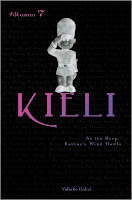But sometimes, someone turns out to be vastly less knowable and more alien than we ever guessed.
In the 1970s, John Backderf was friendly -- not quite "friends," but connected in that loose high school way -- with another boy of the same age, named Jeff Dahmer. And, years later, Backderf was a reporter and editorial cartoonist -- working then as simply "Derf" -- when the news of Dahmer's serial-killing streak finally came to light, more than a decade and seventeen deaths later. My Friend Dahmer
My Friend Dahmer starts with two short sections, setting the scene with a younger Dahmer dissolving roadkill animals in acid in a shack in the woods and being tormented and alone in middle school. But most of the book covers three years of high school, leading up to graduation -- as Backderf and his friends took on Dahmer as a sometimes friend, or, more often, as that weird kid who you can count on to do something outrageous to make everyone laugh. (Dahmer had a fake-cerebral-palsy act, which was either imitating a local interior designer or his own mother's seizures -- or perhaps both -- and this was hugely funny to teenage boys in the mid-70s.)
The called themselves "the Dahmer Club," but they were never really friendly with Dahmer -- he was too weird, too encased in his shell of behaviors at that point. Dahmer was also a full-blown alcoholic by senior year, carrying bottles of hard liquor around (unknown, at the time, to anyone else in the school) in a briefcase and drinking almost constantly. Dahmer was the "class freak" -- the weirdo who acts out, presumably for attention -- but not close to anyone.
Backderf has extensively researched Dahmer's life -- reading all of the many interviews and books, and re-interviewing his friends and schoolmates -- so My Friend Dahmer isn't just "what I remember of that one kid who turned out bad;" Backderf tries to depict what was going on in Dahmer's head at the time. His family was dysfunctional in the best of times, and going through a messy divorce during his senior year -- and Dahmer was not just a still-closeted homosexual, but one whose primary erotic thrill came from imagining completely still bodies, dead or seemingly so. He heard voices in his head, urging him to kill -- and he drank to keep those voices as quiet as he could. But, finally, at the end of his senior year, his parents completely abandoned him -- his father had moved out months before, and then his mother secretly moved out of state with her younger son to return to her family -- and he was left, entirely alone, with only himself and what was in his head. And then, of course, he killed for the first time.
Backderf's point is that someone should have seen what Dahmer was becoming and stopped him; that he could have been helped before he turned into a killer. And a similar boy almost certainly couldn't go through the same progression today -- school campuses are locked more tightly, and obviously drunk students no longer tolerated if they don't cause trouble. But who can know?
Backderf's cartooning has gotten much stronger in recent years: his work used to be just a few small panels of lumpy people talking, but the larger pages of My Friend Dahmer give him space for stronger storytelling, with strong transitions and well-chosen images. His figures are still entirely Derf: lumpy, lanky young men, all legs and arms and joints, with stringy hair and unfortunate clothes and long faces. He draws Dahmer's eyes as utterly still behind his glasses -- or, sometimes, not even showing at all -- a heavy gaze looking straight out at the reader and assessing him for whatever purposes.
Life gave Backderf amazing material for a graphic novel, but he had to actually do it. And he did: My Friend Dahmer isn't impressive simply because Backderf knew and grew up with Dahmer, but because he's spent these last twenty years trying to figure out how he became Dahmer -- and if there was any way that could have been stopped.


























